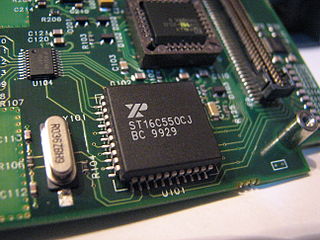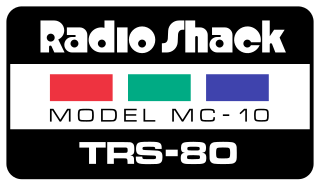
The Commodore 64, also known as the C64, is an 8-bit home computer introduced in January 1982 by Commodore International. It has been listed in the Guinness World Records as the highest-selling single computer model of all time, with independent estimates placing the number sold between 12.5 and 17 million units. Volume production started in early 1982, marketing in August for US$595. Preceded by the VIC-20 and Commodore PET, the C64 took its name from its 64 kilobytes(65,536 bytes) of RAM. With support for multicolor sprites and a custom chip for waveform generation, the C64 could create superior visuals and audio compared to systems without such custom hardware.

The MOS Technology 6502 is an 8-bit microprocessor that was designed by a small team led by Chuck Peddle for MOS Technology. The design team had formerly worked at Motorola on the Motorola 6800 project; the 6502 is essentially a simplified, less expensive and faster version of that design.

MOS Technology, Inc. ("MOS" being short for Metal Oxide Semiconductor), later known as CSG (Commodore Semiconductor Group) and GMT Microelectronics, was a semiconductor design and fabrication company based in Audubon, Pennsylvania. It is most famous for its 6502 microprocessor and various designs for Commodore International's range of home computers.

In telecommunications, RS-232 or Recommended Standard 232 is a standard originally introduced in 1960 for serial communication transmission of data. It formally defines signals connecting between a DTE such as a computer terminal or PC, and a DCE, such as a modem. The standard defines the electrical characteristics and timing of signals, the meaning of signals, and the physical size and pinout of connectors. The current version of the standard is TIA-232-F Interface Between Data Terminal Equipment and Data Circuit-Terminating Equipment Employing Serial Binary Data Interchange, issued in 1997. The RS-232 standard had been commonly used in computer serial ports and is still widely used in industrial communication devices.

The 16550 UART is an integrated circuit designed for implementing the interface for serial communications. The corrected -A version was released in 1987 by National Semiconductor. It is frequently used to implement the serial port for IBM PC compatible personal computers, where it is often connected to an RS-232 interface for modems, serial mice, printers, and similar peripherals. It was the first serial chip used in the IBM PS/2 line, which were introduced in 1987.

The VIC-20 is an 8-bit home computer that was sold by Commodore Business Machines. The VIC-20 was announced in 1980, roughly three years after Commodore's first personal computer, the PET. The VIC-20 was the first computer of any description to sell one million units. It was described as "one of the first anti-spectatorial, non-esoteric computers by design...no longer relegated to hobbyist/enthusiasts or those with money, the computer Commodore developed was the computer of the future."

A universal asynchronous receiver-transmitter is a peripheral device for asynchronous serial communication in which the data format and transmission speeds are configurable. It sends data bits one by one, from the least significant to the most significant, framed by start and stop bits so that precise timing is handled by the communication channel. The electric signaling levels are handled by a driver circuit external to the UART. Common signal levels are RS-232, RS-485, and raw TTL for short debugging links. Early teletypewriters used current loops.
GeoPort is a serial data system used on some models of the Apple Macintosh that could be externally clocked to run at a 2 megabit per second data rate. GeoPort slightly modified the existing Mac serial port pins to allow the computer's internal DSP hardware or software to send data that, when passed to a digital-to-analog converter, emulated various devices such as modems and fax machines. GeoPort could be found on late-model 68K-based machines as well as many pre-USB Power Macintosh models and PiPPiN. Some later Macintosh models also included an internal GeoPort via an internal connector on the Communications Slot. Apple GeoPort technology is now obsolete, and modem support is typically offered through USB.
Asynchronous serial communication is a form of serial communication in which the communicating endpoints' interfaces are not continuously synchronized by a common clock signal. Instead of a common synchronization signal, the data stream contains synchronization information in form of start and stop signals, before and after each unit of transmission, respectively. The start signal prepares the receiver for arrival of data and the stop signal resets its state to enable triggering of a new sequence.

The Commodore Plus/4 is a home computer released by Commodore International in 1984. The "Plus/4" name refers to the four-application ROM-resident office suite ; it was billed as "the productivity computer with software built in".

William David Mensch, Jr. is an American electrical engineer born in Quakertown, Pennsylvania. He was a major contributor to the design of the Motorola 6800 8-bit microprocessor and was part of the team led by Chuck Peddle that created the MOS Technology 6502. He also designed the 16-bit successor to the 6502, the 65816.

The TRS-80 MC-10 microcomputer is a lesser-known member of the TRS-80 line of home computers, produced by Tandy Corporation in the early 1980s and sold through their RadioShack chain of electronics stores. It was a low-cost alternative to Tandy's own TRS-80 Color Computer to compete with entry-level machines such as the VIC-20 and Sinclair ZX81.

The MOS Technology 6522 Versatile Interface Adapter (VIA) is an integrated circuit that was designed and manufactured by MOS Technology as an I/O port controller for the 6502 family of microprocessors. It provides two bidirectional 8-bit parallel I/O ports, two 16-bit timers, and an 8-bit shift register for serial communications or data conversion between serial and parallel forms. The direction of each bit of the two I/O ports can be individually programmed. In addition to being manufactured by MOS Technology, the 6522 was second sourced by other companies including Rockwell and Synertek.

The Western Design Center (WDC) 65C02 microprocessor is an enhanced CMOS version of the popular nMOS-based 8-bit MOS Technology 6502. It uses less power than the original 6502, fixes several problems, and adds new instructions. The power usage is on the order of 10 to 20 times less than the original 6502 running at the same speed; its reduced power consumption has made it useful in portable computer roles and industrial microcontroller systems. The 65C02 has also been used in some home computers, as well as in embedded applications, including medical-grade implanted devices.

The Tangerine Microtan 65 was a 6502-based single board microcomputer, first sold in 1979, that could be expanded into, what was for its day, a comprehensive and powerful system. The design became the basis for what later became the Oric Atmos and later computers. Those later machines have similar keyboard addressing and tape I/O as the Microtan 65. The Microtan 65 has a hardware single step function that can be used for debugging software in both ROM and RAM. The computer was available as ready-built boards or as kits consisting of board and components requiring soldering together.

The Commodore 64 home computer used various external peripherals. Due to the backwards compatibility of the Commodore 128, most peripherals would also work on that system. There is also some compatibility with the VIC-20 and Commodore PET.

The Western Design Center (WDC) W65C134S is an 8-bit CMOS microcontroller based on a W65C02S processor core, which is a superset of the MOS Technology 6502 processor.

The CMOS W65C51 Asynchronous Communications Interface Adapter (ACIA) provides an easily implemented, program controlled interface between microprocessor based systems and serial communication data sets and modems. It is produced by Western Design Center (WDC) and is a drop-in replacement for the MOS Technology 6551.
Apple II serial cards primarily used the serial RS-232 protocol. They most often were used for communicating with printers, Modems, and less often for computer to computer data transfer. They could be programmed to interface with any number of external devices which were RS-232 compatible. Most serial cards had speed ranges starting from 110 bit/s up to 19,200 bit/s, however some could be modified to go much faster. The most popular and widely used of these cards was Apple Computer's Super Serial Card, a solid design that was often copied for maximum software compatibility of the end product.

The Ricoh 2A03 or RP2A03 / Ricoh 2A07 or RP2A07 is an 8-bit microprocessor manufactured by Ricoh for the Nintendo Entertainment System video game console. It was also used as a sound chip and secondary CPU by Nintendo's arcade games Punch-Out!! and Donkey Kong 3.















